This section is intended to provide guidance on the measures necessary to ensure safe carriage of metal loads. Although these take many forms, they can be divided into the following broad categories:
Some types of light load, eg small castings, may be carried on sided vehicles and no additional restraint should be required if the sides of the vehicle are higher than the load. In general, however, additional means of restraint will be necessary. Where loads are carried which could apply localised forces, headboard and sideboards should be reinforced.
Certain general principles apply to all metal loads, and these are outlined below.
The principles outlined in Basic criteria and precautions will apply.
Basic criteria and precautions
In particular, the load should, whenever possible, be placed against the headboard, and evenly spread to keep the centre of gravity as low as possible. The load should be packed and lashed in such a way that no part can move in any direction independently.
The metal processor usually dictates the loading arrangement because the processor usually prepares each lift or coil for transport, eg by wrapping and strapping to appropriate pallets.
All vehicles used for steel cartage should have as part of their equipment a binder, pins and chains for the securing of all articles carried. Chains should be tightened by you before your vehicle leaves the loading area.
In general, chains and tensioners should be used to secure metal loads. The selection of lashing should be based on the principles set out in Basic criteria and precautions.
Basic criteria and precautions
Where ropes or webbing are used, particular care must be taken to avoid contact with sharp edges.
The friction within the metal load will in general be low, particularly if the metal is greased. Friction should therefore be disregarded when methods of restraint are being decided. Suitable wooden chocks must be used to avoid, wherever possible, contact of the steel on the tray of a vehicle.
If the metal is strapped into units for ease of handling, the straps should be in good condition, and should be examined to ensure that they have not been damaged in transit or handling.
Flat rubber placed under and between lifts of clean dry sheet increases friction significantly and thereby improves longitudinal and lateral-restraint.
For cut lengths carried lengthwise refer to figure 62. The load should, whenever possible, be placed against the headboard or baulking with short plates on top of the load and at the front so that they cannot slide forward. When the load consists of two or more lifts along the deck of the vehicle, if axle loading distribution allows, the lifts must be placed in contact, or spacers must be used to prevent the rearmost lift(s) sliding into the other(s). Where possible no lift should be higher than the one in front. Each lift must be restrained in a manner which complies with the principles set out in The safety problem. Where the use of dunnage is unavoidable, it must comply with the conditions set out in The safety problem also, and must be positioned so as to prevent any whip in the load.
As shown in figure 62 each bundle of sheet should be restrained with a minimum of two chains and tensioners which are attached to substantial anchor points. An unsupported section of rope rail cannot be used.
Adequate baulking spacers and protectors must be provided to prevent the load being damaged through contact with lashings. Unused conveyor belting and sections of tyres make excellent protectors.
For an example of cut lengths carried crosswise refer to figure 63. The principles applied are similar to those recommended for cut lengths of metal sheet transported lengthwise, with the addition of the adjustable plate restraints illustrated. Beams with adjustable pegs, in conjunction with the chains and tensioners, provide effective longitudinal and lateral restraint.
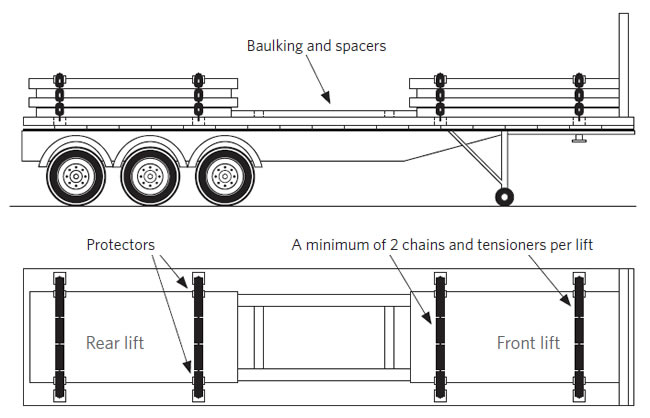
Figure 62 Metal sheet - cut length - lengthwise
 Figure 63 Sheet – cut length – crosswise
Figure 63 Sheet – cut length – crosswiseExamine the deck strength to ensure it is adequate before loading steel coils.
All coils of metal or wire should be blocked each side and the chain drawn through the centre of the front and rear coils to stop any movement forwards, backwards or sideways. This may also require the use of further binders as well as blocks and chains.
Whenever possible, coils should be transported on specially constructed vehicles.
A row of coils is one or more coils in a line across or along the vehicle. All coils in a row must be of approximately equal diameter.
Coils should not be loaded more than one layer high.
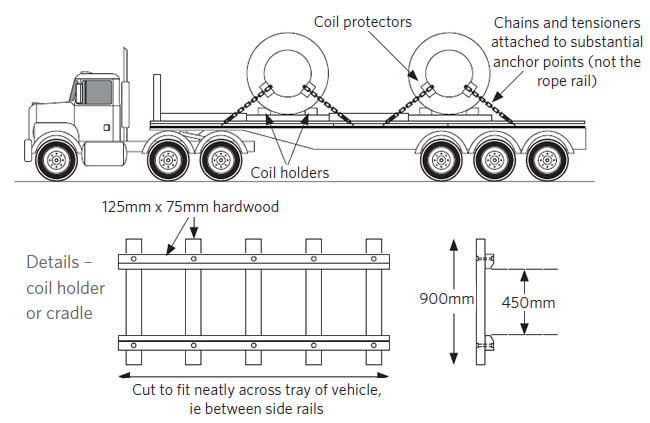 Figure 64 Metal coils – eye horizontal, carried crosswise
Figure 64 Metal coils – eye horizontal, carried crosswiseFigure 64 shows a recommended restraint method for steel coils. The metal processor usually applies metal banks to the bare coils to provide both circumferential and end restraint.
It is important to cradle the coils in coil holders as illustrated. The coil holders must be positioned to distribute the load on the vehicle, to provide legal axle loads. They must fit neatly between the coaming rails to provide lateral restraint.
Fit a pair of chains and tensioners to each row of coils as shown in figure 65. Use coil protectors where indicated. Anchor chains to substantial anchor points, not to a rope rail.
On the rare occasions when coils must be carried in rows aligned along the platform, the rows must be in contact along the centre of the platform and of equal length.
Cradles of the type shown in figure 64 should be used with the addition of 100mm × 100mm timber baulking bolted across both ends of the cradle hard against the end coils. The front baulking may be deleted if the leading coil is hard against a substantial bulk head.
Fit protectors between chains and load where necessary. Apply a minimum of two transverse chains and tensioners across each coil. Anchor chains to substantial anchor points, not to a rope rail (refer figure 65).
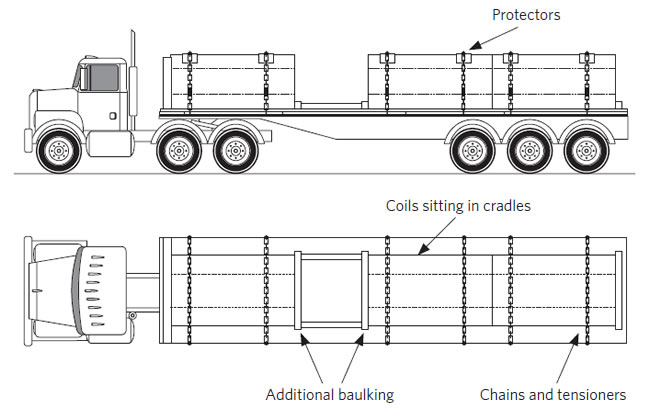 Figure 65 Metal coils – eye horizontal, carried lengthwise
Figure 65 Metal coils – eye horizontal, carried lengthwiseCoils intended to be transported with eye vertical are usually mounted on and strapped to wooden pallets by the metal processors.
The coils and pallets must be positioned to distribute the load on the vehicle and to keep axle loads within legal limits. Restrain the coils with coil inserts, chains and tensioners as illustrated in figure 66.
Note also that the adjustable plate restraint shown in figure 63 may be effectively used as a coil insert. This would mean the use of additional protectors between chains and load would not be necessary.
Pallets should be baulked or secured with a system of front and back restraint chains.
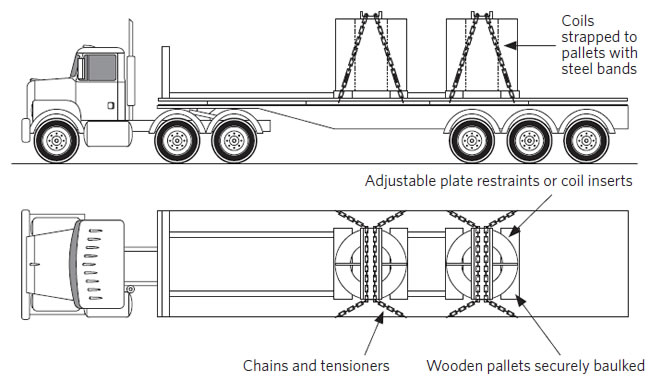 Figure 66 Metal coils, eye vertical
Figure 66 Metal coils, eye verticalThis type of load poses particular problems as one bar can easily penetrate a headboard if it is allowed to move. It is essential that the vehicle is loaded in such a way that the complete load forms a unit and no bar or bars can slip out of the load.
The load must be stable without lashing. If lower layers are lashed to prevent spreading, this must be done before the next layer is put in place. Lashings must not support the weight of the upper layers. If the bars are laid along the platform, where possible, no bundle or pile should be bigger than a bundle or pile in front of it, and piles must be in contact or baulked to prevent forward motion.
Each pile must have sufficient cross lashings to comply with the conditions outlined in Basic criteria and precautions.
Basic criteria and precautions
If it is possible to baulk against sideways movement, this should be done. It may be necessary, if the load is not against the headboard, to provide baulking to the height of the load at the front to prevent forward movement.
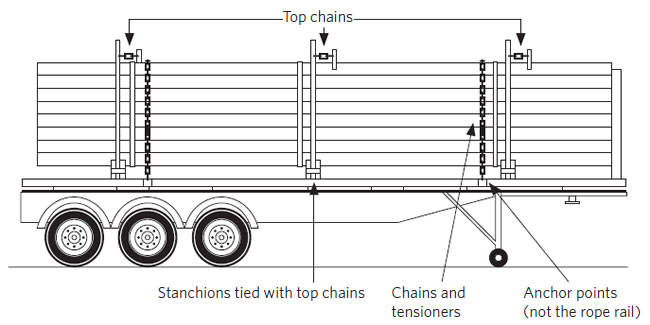 Figure 67 Steel bars, billets and pipes
Figure 67 Steel bars, billets and pipesMany of the problems associated with metal bars also apply to structural steel and pipes, and, in particular, to maintaining the load as a solid unit (for arrangement of the load on the platform see figure 67). The load should, whenever possible, be placed against the headboard or baulking, which should extend to the full height of the load. The load should be kept as low as possible, and smaller items placed on top. No layer should be bigger than the one beneath it.
The headboard or loading rack should be of sufficient height for driver protection.
The selection and use of lashing should be based on the principles set out in Load-securing equipment.
Whenever possible, stanchions, either attached to the vehicle or to specially made bolsters, should be used to provide lateral restraint. The stanchions should extend to the height of the load and be fitted with top chains. If there are no stanchions, baulking should be used to prevent lateral movement. It is essential that the load be restrained in such a way that no single part of it is free to move in any direction independently of the rest. The use of dunnage should be avoided wherever possible, but if necessary, then it should comply with the requirements described in Basic criteria and precautions.
Basic criteria and precautions
Figures 68 and 69 illustrate methods of securing prefabricated structural steel and rolled steel members. The prefabricated structural steel is secured by chains spaced at 2 metre intervals attached to anchor points and fitted with load binders. The structural members are spaced above the vertical platform and from each other by 100mm × 50mm wooden spacer blocks placed at the position of the chains and load binders.
Rolled steel members are similarly restrained. Care must be taken in all cases to ensure that the front of the load is against a headboard or baulking to prevent forward movement. The load should be positioned to achieve the desired axle loading.
 Figure 68 Prefabricated structural
Figure 68 Prefabricated structural 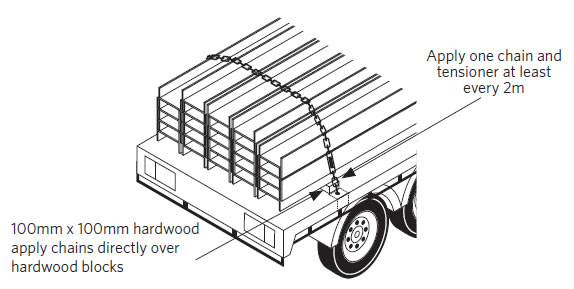 Figure 69 I-beams
Figure 69 I-beamsThis type of load is usually carried in a custom-made cradle, which must be sufficiently strong to resist the forces which might be imposed on it.
It will often be impossible, for weight distribution reasons, to place this type of load against the headboard. Therefore, if no baulking is provided, all the restraint will have to come from the lashings, and a correspondingly greater number will be necessary.
The lashings must be arranged to prevent the load toppling as well as preventing movement relative to the vehicle. It will be necessary to lash over the top, or to points high on the load or cradle, even if baulking at deck level is used to provide the majority of the restraint.
Wire coils carried on custom-designed vehicles according to the manufacturer’s recommendation will be secure.
When carrying coils on a flat platform vehicle you will, in general, need to place them in rows along the platform. It will be necessary to place the front coils against a vertical obstacle, usually the headboard, to prevent them falling over. All coils behind them must be kept as nearly vertical as possible. The rows of coils along the deck must be in contact with each other.
The coils must be baulked against sideways movement along the entire length of the load. The rearmost coils must also be baulked against rearward movement.
The lashings must prevent the coils from rocking backwards and forwards under braking and acceleration. Therefore, particular care must be taken to lash forwards from the rearmost coils. The lashings must comply with the basic criteria and precautions requirements as set out in Basic criteria and precautions.
Basic criteria and precautions
Scrap metal can be of many forms and may or may not come into one of the categories itemised above. If it does, then the loading and lashing arrangements must be as outlined in Loose bulk loads.
Scrap metal may be carried in sided vehicles. The conditions which must be met are outlined in the Loose bulk loads section. Care must be taken with loads of scrap to ensure that the load forms a complete unit, and all parts of it are secured to the standards outlined in Basic criteria and precautions.
Basic criteria and precautions
It is preferable that scrap metal be placed in containers at the point of origin so that it can be handled by a crane from the ground to the truck. Care must be exercised to ensure that the loaded containers are suitably placed on the vehicle so that at no time is the aggregate weight of the vehicle or any axle load limits exceeded.
Ingots can be in many forms. Details of the loading and lashing arrangements are outlined in the pallet and general freight sections. Ingots can be carried in sided vehicles, or palletised on platform vehicles. Care must be taken to ensure that the load is safe and secure.